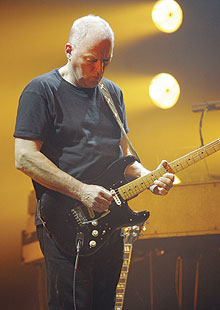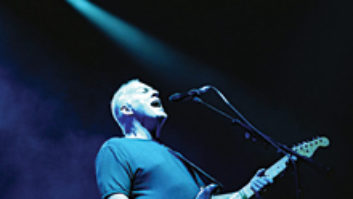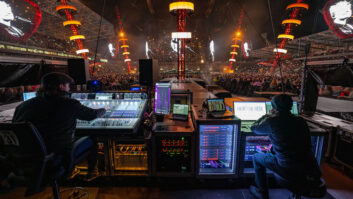
Just a few hours before David Gilmour hits the stage in one of the most anticipated shows to come to the United States this spring, front of house engineer Colin Norfield and monitor engineer John Roden are sitting in the plush seats of the Paramount Theater (Oakland, Calif.) and laughing.
Any other audio duo might be a tad nervous before a show of this stature, but Norfield and Roden have been around the block; Norfield mixed the last Pink Floyd tour 12 years ago. They also know they have a team of seasoned veterans, both onstage and in support positions, and they have already worked one of the hardest shows of the tour.
“We rehearsed the band for a week and then we did David’s birthday party — a private gig in front of his peers. It was a bit brave of him and it was a bit brave for us,” Roden recalls while pointing to Norfield, “because we were off the stage side by side.”
“I couldn’t hear anything,” Norfield adds with his own laugh, “and I spent the night leaning over the console.”
After the birthday gig at Porchester Hall in London, the cast and crew of the On An Island tour made their way from Germany to France and Italy before North American dates in New York City, Toronto, Chicago, Oakland and Los Angeles. Gilmour’s touring band includes keyboardist/singer Richard Wright (who sang the lead on Pink Floyd’s first single “Arnold Layne,” which was performed for the first time since 1969), guitarist (and Gilmour’s co-producer) Phil Manzanera, bassist Guy Pratt, keyboardist Jon Carin and drummer Steve DiStanislao.

The jump across the pond was made a bit easier by the fact that they carried the same gear in the States as they did overseas. “We are both running [DiGiCo] D5s,” Roden reports. “Colin has the same [Turbosound] Aspect P.A. and I’ve got the same Turbo wedges [TFM-420s and TFM-450s]. Of course, the amps are different and the power is different, but in theory, it’s the same gig. At the end of the day, it was the most sensible option, because at least there is some consistency to what the musicians see and hear coming off of the back of the cabinets.”
At FOH, Norfield is using a D5 and outboard gear that includes a TC Electronic M6000, TC’s D-Two and three Yamaha SPX990s. “That’s about it,” he says. “My view of all gigs is simplicity, because the simpler you make it, the more you can concentrate on mixing and not messing around with other stuff.”
Indeed, other than standard delays and reverbs that come from the players themselves, the only time that Norfield played up an effected track was when Gilmour sang “Coming Back to Life” and a delay was used in the first chorus. He doesn’t believe it’s his job to alter the band’s sound to his ear. “Everything comes from the band, and to mess around with it too much would change the thing it’s about. The dynamics are coming from the band, and I deal with it as it comes. I just put it in its right place, but the actual essence comes from the band. It would be wrong for me to try and change that.”
The Turbosound Aspect system was selected before rehearsals started. “David told me he didn’t really like line array systems, so my options were really cut down because that’s all there was out there,” Norfield says. “We used a Turbosound Flashlight/Floodlight combination on the last tour, and we went down and did an A/B comparison with the new stuff. It’s nice. The high end is lovely and the top is very sweet. It’s working very well.”

FOH engineer Colin Norfield at the D5
photo: Steve Jennings
Norfield went conventional while miking the band, putting a Shure Beta SM91 and Beta 52 on kick, Sennheiser 421s on the toms, an SM57 on snare, and Beta 98s on the Roto Toms; hi-hats are miked with an SM81, with AKG 414s on overheads. Shure KSM-32s are on guitar cabinets (for Gilmour and Manzanera). The bass inputs are direct, and the pair of Leslie cabinets (both Wright and Carin each use one) are miked with a 421 on the bottom of the Leslie and a 57 on the top. The sax microphone is also a Sennheiser 421. All of the vocal mics are Neumann KSM-105s.
Norfield has a stock of dbx 166 compressor/limiters, dbx 160As and Drawmer DS-201 noise gates, but they are used sparingly. “The more open the better,” he says. “I’m pretty well known for open mixing and I try not to do too much. There’s not much compression, because everyone is singing — nobody’s really screaming.”
Roden selected a D5 on monitors because he looked at the tour and realized, “big input, no room. I think we’re both using the digital formats because of the limitations we’ve been given. It would not have been my first choice. If we were doing stadiums or arenas, I would probably have been using a couple of Midas H-3000s, but we just don’t have the space.”
The power of the D5 also gives a number of options, yet Roden points out he’s mixing in a very analog way. “I’m not using any of the preset scenes. The basic thing is exactly the same on each song, but because of way they play, Rick [Wright] might get excited one night and you’ll get loads of level off the Leslie, and one night he might not be quite so excited. You can put yourself in the ballpark, but it’s not a machine playing. They are human beings and they make mistakes and we make mistakes and hopefully they make more than we do,” he says with a laugh.
There was no talk of using personal monitors on Gilmour. “What I do for David is very simple: vocal, acoustic guitar, a couple of cues here and there,” says Roden. “When he plays the guitar, he puts himself in a spot that’s sweet for him, where he can hear everything he needs to hear, and plays — letting the band do all the work. He finds that sweet spot.” The only person using a personal monitor — and only in one ear — is the drummer.

Monitor engineer John Roden
photo: Steve Jennings
Of course, the use of wedges has caused Norfield some worry at FOH. “I did mention my concerns at rehearsal about volume at some of the venues, but after that it’s up to me to deal with it,” he explains.
As the clock ticks closer to showtime, Roden and Norfield think about the impact of this tour as well as Gilmour’s catalog of songs on the fans. “When we were in Toronto, there was a woman who cried through every Pink Floyd song that David played,” Roden remembers.
“People go right back to where they were when they heard these songs,” Norfield adds. “When ‘Wish You Were Here’ comes on, people go back 30 years. They aren’t here anymore.”
David John Farinella is a San Francisco — based writer.






